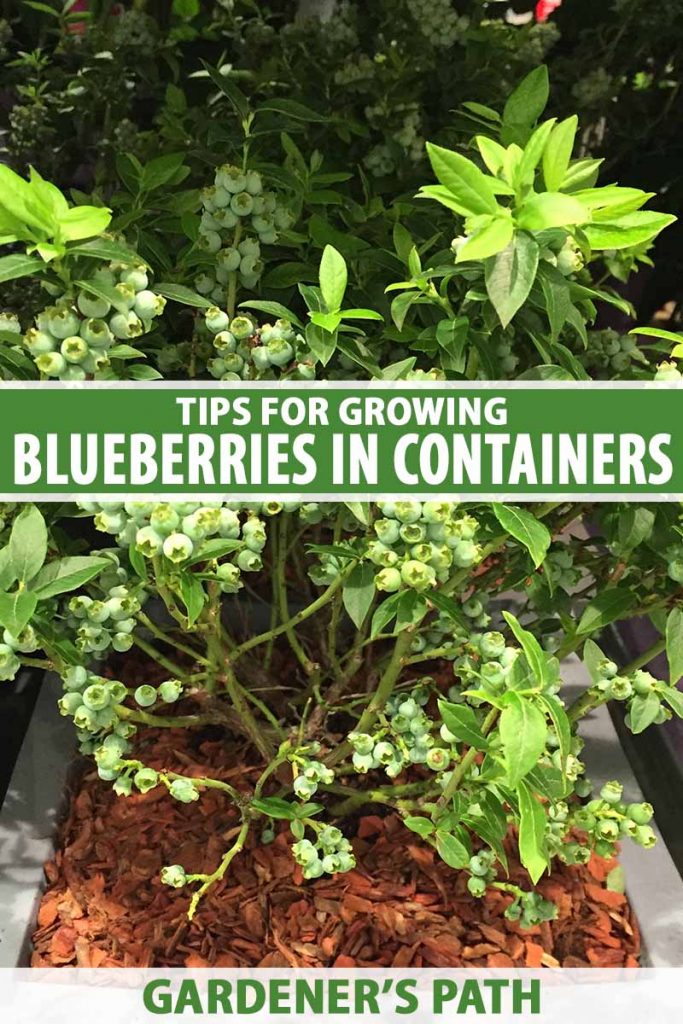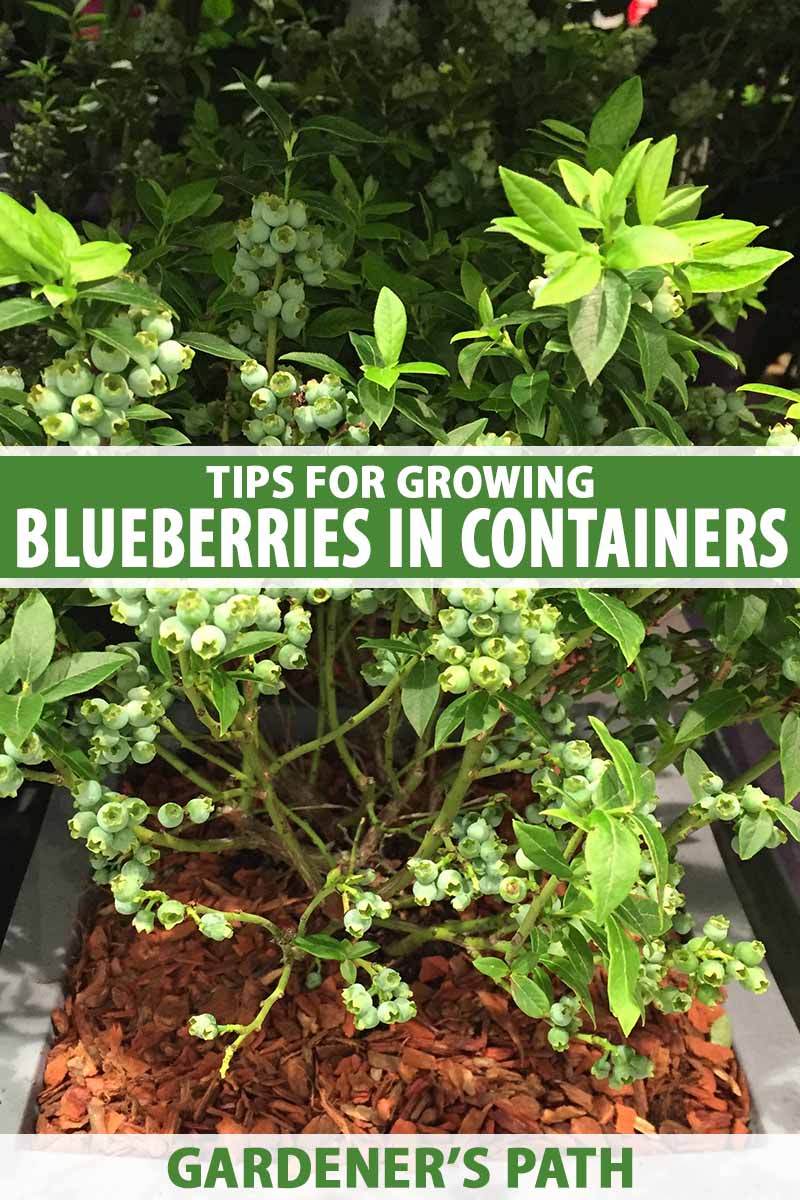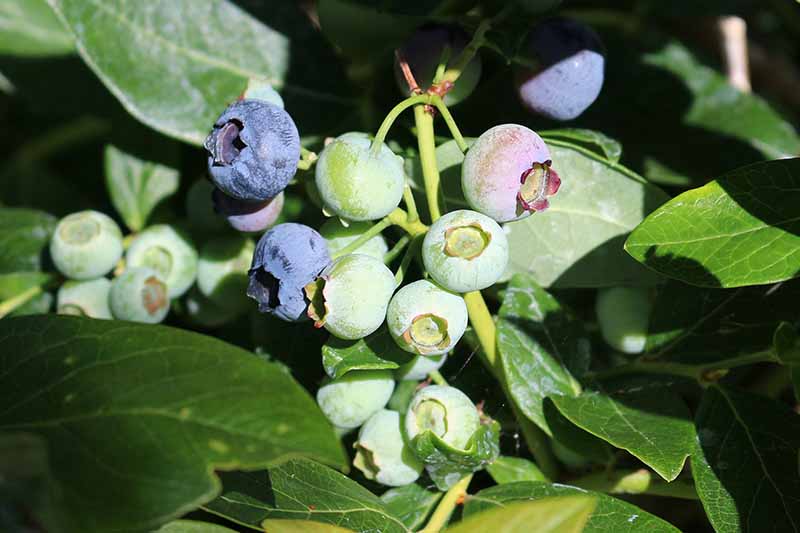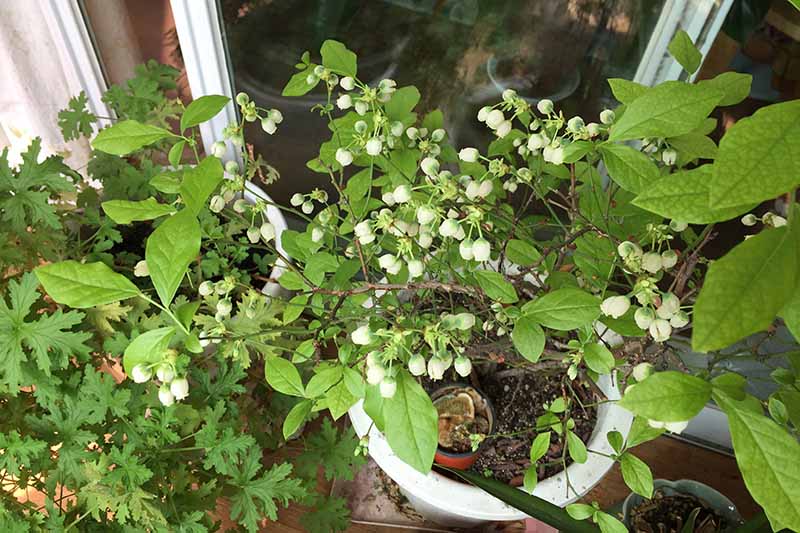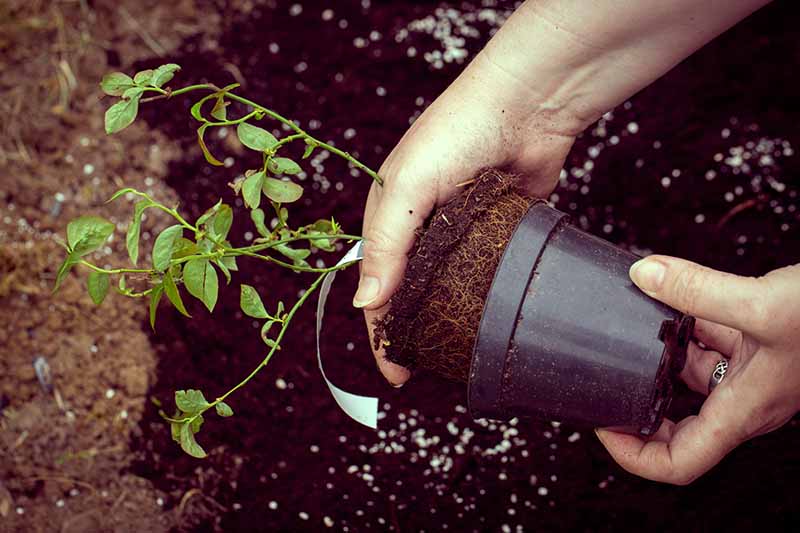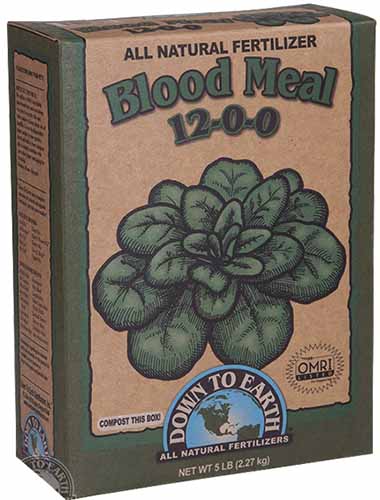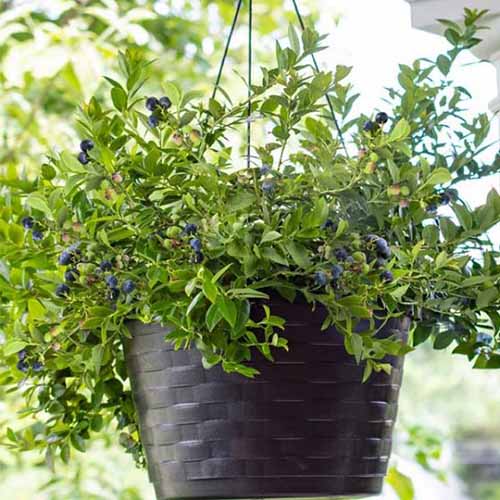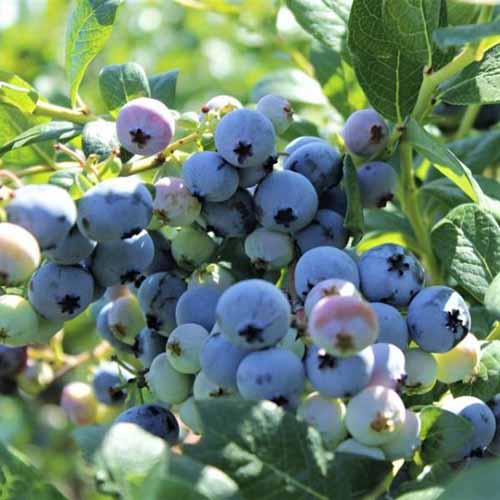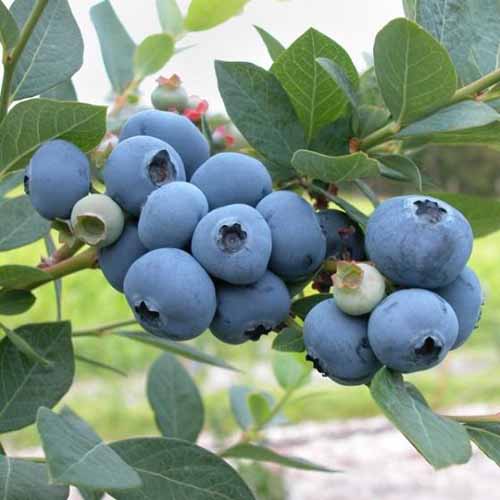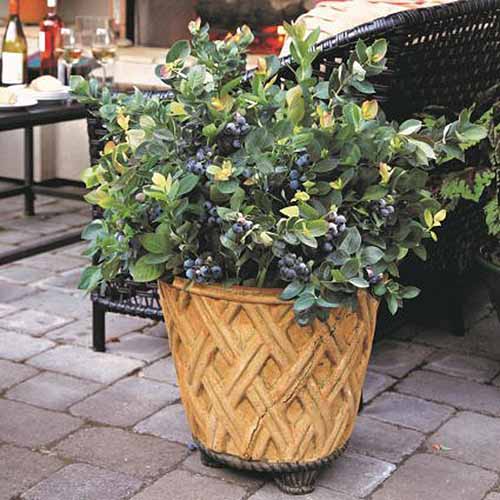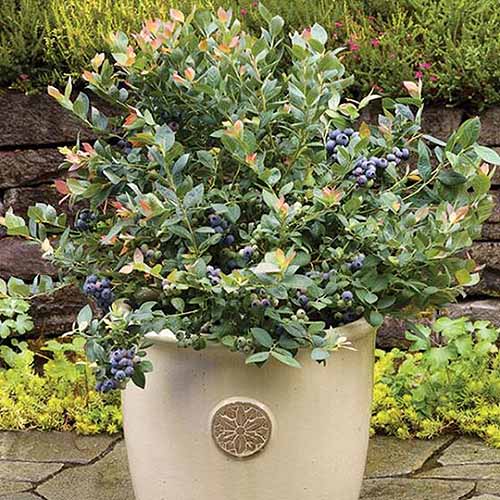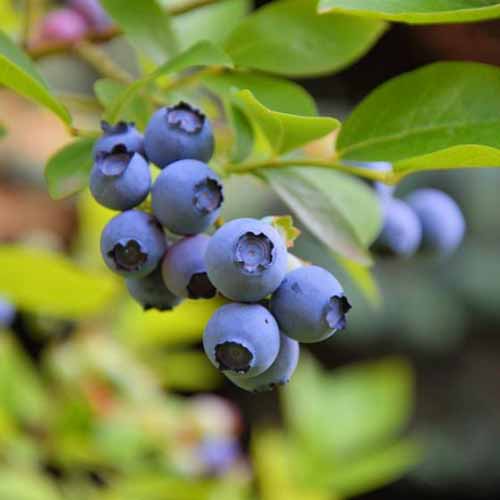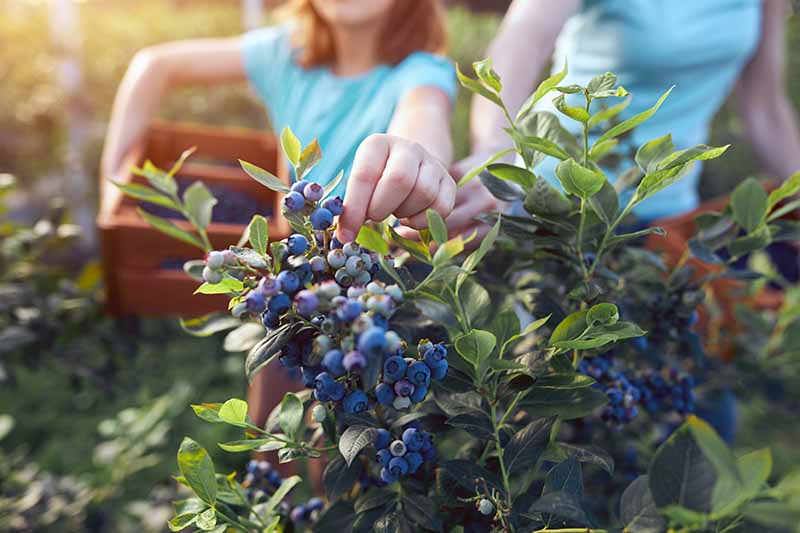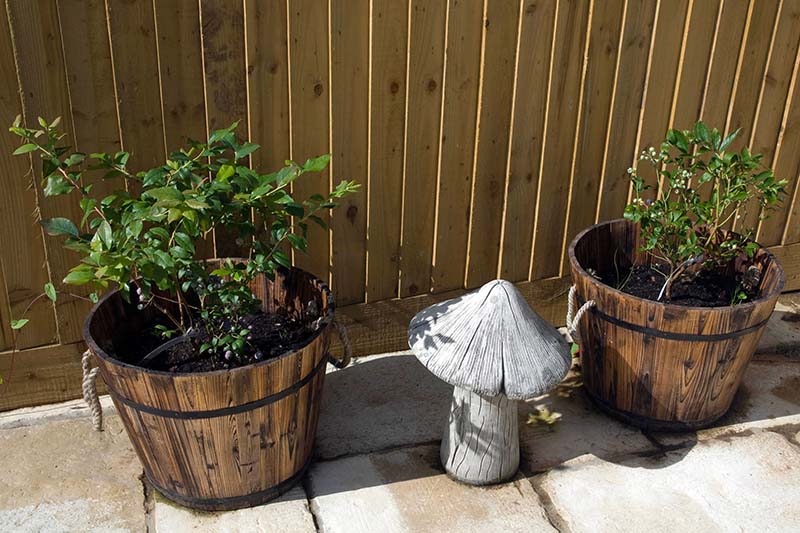Maybe your mouth is watering while you’re reading this. But for those of you who only have a balcony or a small patio, or maybe the wrong soil type or garden plots that are already full to the brim, the dream of growing your own blueberries can seem out of reach. Until now! Blueberries will grow, bloom, and yield fruit quite happily in a container. We link to vendors to help you find relevant products. If you buy from one of our links, we may earn a commission. In our guide to growing blueberries we cover how to cultivate these shrubs in your landscape. Below we share everything you need to know to grow these delicious berries in containers in whatever outdoor space you have. Here’s what’s ahead:
Getting Started
You’ll probably encounter several types of blueberries while looking for a bush to put in a container. The lowbush or wild blueberry, Vaccinium angustifolium, is native to Canada and the northeastern US, while the rabbiteye, V. virgatum (aka V. ashei), is native to the southeastern US. The type most commonly grown in containers, though, is the highbush. The northern highbush, V. corymbosum, is the most commonly planted type in the world. Southern highbush is a cross between northern highbush and V. darrowii, which is a southeastern US native. There are a variety of dwarf highbush cultivars specifically developed for growing in containers, and we’ll cover some of the best in the Cultivars to Select section below. When choosing between northern and southern highbushes for your own patio, you need to keep in mind that blueberries have specific chill requirements. This means they require a certain number of chill hours (or the number of hours per year with temperatures of 45°F or below) for the bush to leaf out, bloom, and fruit properly. Northern highbushes need over 600 chill hours, while southern highbushes are considered “low chill” and, depending on the cultivar, may require only 150 to 500 chill hours. If you live in a warmer climate, say in Zone 9 or higher, low chill varieties are for you!
Why Grow in Containers?
If you are itching to develop your green (berry stained) thumb but don’t have any more space in your garden, only have space on your patio, or are limited to a balcony, there’s your why! It’s easier to control and manipulate both the moisture and pH level of the potting medium in containers than it is in the ground, key factors in growing blueberries because they are picky about having acidic soil, and are sensitive to overly wet or dry conditions. Growing in containers is also a good option if you don’t have naturally acidic soil, or struggle with waterlogged soil. Plus, birds are less likely to target ripe berries that are safely positioned on a patio than ones growing out in the quiet of a garden. Not only are the berries delicious, but blueberry bushes are beautiful ornamental plants. Think loads of sweet white-pink blooms in the spring, green foliage and purple-dusty blue fruit in the summer, and a riot of red or orange foliage in the fall.
Choosing the Right Container
Size and drainage are the most important considerations when choosing a container to house your blueberry bush. Pick one that has drainage holes and is weatherproof. For example, a large wooden barrel makes a perfect planter. Keep in mind, though, that the larger and heavier the container is the harder it will be to move around. Either pick a perfect permanent spot, or choose a smaller pot that will be easier to move when necessary. For most mature cultivars, the container size should be about 24 inches deep and 24 to 30 inches wide. If you buy a younger plant, you can start with a smaller pot and plan to repot as it grows. No patio or balcony space left at all? Trying a dwarf variety in a hanging basket isn’t as crazy as it sounds. We’ll talk about this in the cultivar section below.
Planting
Plant or repot your bushes in the late summer or early fall, so the roots have time to develop and spread into the new soil before the winter. Prepare your container by filling with a 50-50 mix of azalea or hydrangea potting soil and peat moss. Wet thoroughly. Create a hole in the potting medium that’s double the size of the original pot. If your shrub is pot bound, gently tease out the roots to encourage them to grow into the new medium. Plant so the surface of the soil is at the same depth on the stem as it was originally. Water in well, and continue to water regularly as needed while your plant is becoming established.
How to Grow
Unlike most plants, blueberries don’t have root hairs, which increase root surface area. This is why they are very sensitive to changing soil and water conditions. These bushes need acidic soil, with a pH of 4.3-5.5. Consider doing a soil test annually to track pH, since these plants are particularly sensitive to changes. Acidic fertilizer can help keep the soil pH low and nutrients available while feeding the plant, but the source of nitrogen and other elements that make up that NPK ratio in your chosen fertilizer can also make a difference, if you select a blended product. Urea fertilizer is half as acidifying as ammonium sulfate, so use a urea- based product if the soil pH is less than 5.0. Fertilize in the early spring as the leaves begin to emerge. Apply fertilizers according to the package instructions. You can work granular fertilizers into the surface of the medium or just broadcast on the surface. Down to Earth Blood Meal Try to avoid fertilizers that are high in chlorides or nitrates, with nitrogen sourced from ammonium nitrate or potassium nitrate, for example. Be careful not to over fertilize, as this can burn the foliage and roots, cause weak growth that is more prone to insect and disease damage, and encourage the growth of leaves at the expense of fruit. Get more tips on fertilizing blueberry bushes here. Blueberries do best in full sun, but providing some late afternoon shade is a good idea in hot climates. Place on a patio or balcony, or in a sunny spot in your garden. Keep the soil moist but do not allow it to become waterlogged. Shrubs growing in the ground need about an inch of water per week, but container soil tends to dry out quicker, so keep an eye on them.
Growing Tips
Place your containers in full sun for best yields.Plant in acidic soil.Keep the soil moist but avoid over watering.
Pruning and Maintenance
Prune mature plants in late February or March to maintain the perfect shape and desired size. Remove any dead or diseased twigs and branches. In addition to fertilizing, discussed above, every two to three years you can scrape out a third of the old potting soil, and replace it with fresh acidic potting soil or compost to maintain the low soil pH that’s required. Mulch pots in the fall with two inches of an acidic mulch, such as pine needles, conifer wood chips, or bark chips, to protect the roots during the winter and maintain soil moisture. Keep the mulch two inches away from the stem.
Cultivars to Select
If you only want one patio blueberry, make sure to check whether the cultivar you are purchasing is self pollinating. While most northern highbush and some southern highbush cultivars are self fertile, placing another variety nearby that blooms at a similar time allows for cross pollination. This usually results in bigger fruit, and larger yields. Dwarf varieties work great as patio and balcony container plants, but if you have a little more room or want to create a hedge or screen, taller varieties work well too.
Managing Pests and Disease
Blueberry bushes are quite resilient and even if pests do appear, often it takes five to eight years for populations to rise high enough to cause significant damage. Named for the fruit that tastes as if it’s been sweetened, ‘Jelly Bean®’ is a dwarf northern highbush cultivar that grows to one by two feet and is hardy in Zones 4-8, but note that it requires over 1,000 chill hours. ‘Jelly Bean’ From the Bushel and Berry™ series, ‘Jelly Bean®’ (aka V. corymbosum ‘ZF06-179’) produces high yields and features year-round foliage. You can find plants in one- or three-gallon containers available at Nature Hills Nursery.
Midnight Cascade
Remember that crazy hanging basket idea I mentioned earlier? ‘Midnight Cascade’ (V. corymbosum ‘FC12-187’) is the perfect cultivar for it, another northern highbush option from the Bushel and Berry™ series. It has a unique trailing and spilling habit and grows to only one and a half to two feet tall and wide. ‘Midnight Cascade’ Hardy in Zones 5-9, this variety needs 450 chill hours, and is a high yielding cultivar. Find yours in a one-gallon basket at Nature Hills Nursery.
Northsky
As its name suggests, this variety, a hybrid of V. corymbosum and the wild lowbush V. angustifolium, is very cold hardy and will grow happily in Zones 3-7. ‘Northsky’ grows from two to four feet high and wide and needs over 800 chill hours. ‘Northsky’ Though yields can be quite small, the taste of these berries is reminiscent of the wild variety. ‘Northsky’ is available in one-gallon containers at Nature Hills Nursery.
Patriot
Another northern highbush type, ‘Patriot’ is a popular choice for both containers and in-ground plantings. It grows from four to eight feet tall and three to five feet wide. ‘Patriot’ And, hardy in Zones 3-7, ‘Patriot’ needs 800 to 1,000 chill hours. It’ll produce a lot of delicious berries for you. Find dormant bare roots as well as live plants in three- or six-gallon containers at Nature Hills Nursery.
Peach Sorbet
This northern highbush cultivar (also known as ‘ZF06-043’ ), also from Bushel and Berry™, displays pastel leaf colors and is very small, only growing to one and a half feet high and two feet wide. ‘Peach Sorbet’ It is hardy in Zones 5-10, requires only 300 or less chill hours, and is high yielding. Find ‘Peach Sorbet®’ in one-gallon pots available at Nature Hills Nursery.
Pink Icing
Hardy in Zones 5-10 and requiring 500 chill hours, ‘Pink Icing®’ (aka ‘ZF06-079’), another northern highbush variety from the Bushel and Berry™ series, will grow three feet high and four feet wide. ‘Pink Icing’ It produces a moderate yield, and features colorful foliage with streaks of pink in the springtime for added ornamental value. You can find ‘Pink Icing®’ in one-gallon containers available at Nature Hills Nursery.
Sunshine Blue
On the opposite end of the spectrum from ‘Northsky,’ this southern highbush cultivar is hardy in Zones 5-10 and needs a mere 150 chill hours. It grows three to four feet tall and wide, and has moderate yields. ‘Sunshine Blue’ Also well named, ‘Sunshine Blue’ loves the sun and heat of southern California, so this is an excellent choice for warm climates! You can find ‘Sunshine Blue’ in one- or two-gallon pots available at Nature Hills Nursery. Below are a few pests that can affect your container blueberries.
Birds
Notorious berry lovers, birds are enough of a problem to motivate commercial growers to completely cover their patches in bird netting. These feathered berry gobblers have a knack for spying and gulping any ripe fruit before you can get to it. Placing containers in higher traffic areas, such as on a front porch, might be enough to keep the birds away from your precious fruit. Shiny silver tape wound around plant stems and fluttering in the breeze can also help to deter winged visitors. You can learn more about how to protect your blueberries from birds in our guide.
Insects
Keep an eye out for the following insects in your container blueberries.
Aphids
Aphids can cause leaves, especially new growth, to curl and become deformed, their honeydew exudates can feed sooty mold on fruit and leaves, and they can transmit viruses. This product is safe for humans and their pets, pollinators, and beneficial insects, and can be used right up until harvest. Organocide Bee Safe 3-in-1 Garden Spray If populations continue growing you can try applying a product such as Oganocide Bee Safe 3-in-1 Garden Spray, available at Arbico Organics. Learn more about how to manage aphids in our guide.
Spotted Wing Drosophila
Drosophila suzukii (aka SWD) is a serious agricultural fruit pest, a tiny vinegar fly (or fruit fly) that lays its eggs inside fruit. Oviposition leaves scars on the fruit surface and the larvae feed inside the fruit, causing it to go mushy. This also increases susceptibility to fungal and bacterial infections. Learn about organic ways to control spotted wing drosophila here.
Disease
The main cause of disease in container-grown shrubs is water related.
Phytophthora Root Rot
Overwatering and poor drainage can result in the water mold (oomycete), Phytophthora cinnamomi getting the upper hand in the roots. Symptoms such as reduced new growth, leaf yellowing or reddening, eventual leaf drop, crown and root reddening, and necrosis may take years to become obvious. A more subtle but immediate sign of root rot can be reduced vigor during hot periods. Root rot symptoms can mimic iron deficiency, which causes leaf yellowing known as chlorosis. Iron deficiency is common when the soil pH is too high. Before treating or fertilizing, do a soil test to determine if nutrient deficiency could be a concern or if the symptoms are related to root rot. Phytophthora cinnamomi lives in the soil and only becomes a problem when soil moisture is high enough that specialized spores can swim to and infect the roots. You can prevent this issue by making sure the potting medium is well draining and the container has drainage holes. Lift pots off of hard smooth surfaces that might impede drainage and set them on some bricks or risers instead. Try not to water when the soil is hot. Find more tips on identifying and controlling blueberry pests and diseases here.
Best Uses
What are the best uses for container-grown blueberries? Eating! That’s all I need to say, right? I won’t stop there, though. Edible landscaping is in. Growing your blueberry bushes in containers opens a world of possibilities, especially when it comes to placement. You can grow them on a sunny patio, porch, or balcony and simply reach out the door or window for a delicious snack. Not only do they produce tasty treats, they are also highly ornamental. Surround your sitting area with interest and color throughout the seasons with these potted shrubs. Thanks to their small, pretty blooms in spring, luscious berries in summer, and the bright red foliage of autumn, they are a delight to behold. Some cultivars will even keep their leaves over the winter. Growing your bushes in containers is an option for anyone who doesn’t have a garden, enough free space, the right type of soil, or whoever wants to add a pretty, tasty plant to their patio. Leave us a comment with any questions and share your experiences growing blueberries in containers. We wouldn’t mind finding a few delicious recipes below either (hint hint)! And for more information about growing blueberries, check out these guides next:
Tips for Growing Highbush Blueberries in Your GardenHow to Harvest Perfectly Ripe BlueberriesHow to Propagate Blueberry BushesHow to Transplant Blueberry Bushes
